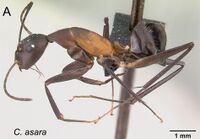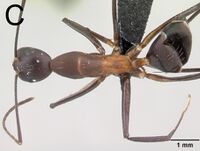Camponotus asara
| Camponotus asara | |
|---|---|

| |
| Scientific classification | |
| Kingdom: | Animalia |
| Phylum: | Arthropoda |
| Class: | Insecta |
| Order: | Hymenoptera |
| Family: | Formicidae |
| Subfamily: | Formicinae |
| Tribe: | Camponotini |
| Genus: | Camponotus |
| Subgenus: | Myrmosaga |
| Species: | C. asara |
| Binomial name | |
| Camponotus asara Rakotonirina & Fisher, 2022 | |
Camponotus asara is endemic to Madagascar and geographically restricted to the dry forest of the PN Zombitse in the southern high plateau of the island and the relict montane rainforest of the PN Ambohijanahary. Colony nests can be in rotten logs and in rot pockets above the ground. Workers have been found foraging in leaf litter and on the ground.
Identification
Rakotonirina and Fisher (2022) - With head in full-face view, lateral margins of head anterior to eye level, parallel, and lacking erect hairs; lateral cephalic margin rounding to posterior margin; anteromedian clypeal margin continuously forming broad convexity; propodeal dorsum more or less straight and separated from declivity surface by broad angle.
Camponotus asara is morphologically similar to Camponotus bozaka and Camponotus becki in that its petiolar node is more or less compressed anteroposteriorly in lateral view and its body color is black to dark brown, or the posterior portion of the mesosoma is pale brown to yellow. However, C. bozaka has a scalelike petiolar node, short and high mesosoma, and propodeal dorsum that joins the declivity in a blunt angle with a length < 2 × height of the declivity, the junction being angulate. Regarding C. becki, its anteromedian clypeal margin is truncate and a few erect hairs are present on the lateral margin of the head behind the level of the posterior ocular margin.
Keys including this Species
Distribution
Distribution based on Regional Taxon Lists
Malagasy Region: Madagascar (type locality).
Distribution based on AntMaps
Distribution based on AntWeb specimens
Check data from AntWeb
Countries Occupied
| Number of countries occupied by this species based on AntWiki Regional Taxon Lists. In general, fewer countries occupied indicates a narrower range, while more countries indicates a more widespread species. |

|
Estimated Abundance
| Relative abundance based on number of AntMaps records per species (this species within the purple bar). Fewer records (to the left) indicates a less abundant/encountered species while more records (to the right) indicates more abundant/encountered species. |

|
Biology
Castes
Nomenclature
The following information is derived from Barry Bolton's Online Catalogue of the Ants of the World.
- asara. Camponotus asara Rakotonirina & Fisher, 2022: 44, figs. 27B, 28A, 42 (s.w.) MADAGASCAR.
- Type-material: holotype worker, 3 paratype workers.
- Type-locality: holotype Madagascar: Toliara, PN Zombitse, 19.8 km. 84° E Sakaraha, -22.84333, 44.71, 770 m., 5-9.ii.2003, BLF07523 (B.L. Fisher, C.E. Griswold, et al.); paratypes with same data.
- Type-depositories: CASC (holotype); BMNH, CASC (paratypes).
- Distribution: Madagascar.
Unless otherwise noted the text for the remainder of this section is reported from the publication that includes the original description.
Description
Worker
Morphological measurements: see Appendix 1 and Morphological measurements: see Appendix 1 and Ratios of morphometric data for majors and minors
Minor In full-face view, head sides anterior to level of eye parallel, converging progressively to posterior margin behind eye level; eyes protruding and large (EL/CL: 0.26±0.01; 0.23–0.28), breaking lateral cephalic margin, level of its posterior border approximately located at posterior 1/4 of head (PoOc/CS: 0.26±0.01; 0.24–0.28); frontal carinae posteriorly parallel (FR/CS: 0.26±0.01; 0.23–0.27); clypeus without well-defined anterolateral angle, its anteromedian margin broadly convex; mandible with six teeth, the two apical teeth distantly spaced; antennal scape relatively long (SL/CS: 1.57±0.08; 1.38–1.68). Promesonotum weakly convex, mesopropodeum almost flat; mesonotum flat immediately anterior to weakly visible metanotal groove; propodeal dorsum approximately straight, rounding progressively towards declivity; propodeal declivity ca. 1/3 length of dorsum. Petiolar node flattened anteroposteriorly or short and high, tapering dorsally; femur of hind leg flattened laterally and twisted near base.
First and second gastral tergites with a pair of white spots; erect hairs lacking on lateral margin of head; posterior margin of head with a pair of erect hairs; antennal scape only covered with appressed hairs; pronotum with a pair of erect hairs; posterodorsal angle of propodeum without erect hairs.
Major With characteristics of minor worker, except for the following characters: enlarged head (CS: 3.22±0.15; 3.03–3.39; CWb/CL: 0.93±0.01; 0.92–0.93) with noticeable medial excision on posterior margin; straight anterior clypeal margin; apical 1/4 of antennal scape surpassing posterior cephalic margin; propodeum dorsum and declivity the same length.
Type Material
- Holotype worker. MADAGASCAR: Province Toliara: PN Zombitse, 19.8 km 84° E Sakaraha, -22.84333, 44.71, 770 m, tropical dry forest, ex rotten log, 05–09 Feb 2003 (Fisher, Griswold et al.) collection code: BLF07523, specimen code: CASENT0493252 (CAS).
- Paratypes. 3 workers, same data as holotype but with the following specimen codes: CASENT0493251, CASENT0837576, CASENT0837577 (NHMUK, CAS).
Etymology
The species name asara is a non-Latin singular noun used in apposition.

